#Native App Development Advantages
Explore tagged Tumblr posts
Text
#Benefits of Native Application Development#Native App Development Advantages#Why Choose Native App Development#Native vs Hybrid App Development#Advantages of Native Mobile Applications#Native App Development for iOS and Android#Native Mobile App Benefits#Native Application Development Pros#Performance Benefits of Native Apps#Why Build Native Mobile Applications
0 notes
Text
React Native or Native: Which Is Superior for Developing Apps?

In today’s digital ecosystem, mobile applications are pivotal for engaging users and driving business success. One of the earliest decisions developers and business owners must make is choosing the right technology for their mobile apps: React Native or Native development. Each option brings distinct advantages and trade-offs depending on the project's needs, budget, and long-term goals. This blog explores the strengths and limitations of both approaches to help you determine which is superior for your app development journey in 2025 and beyond.
Understanding the Basics: What Is React Native and Native App Development?
React Native is a popular open-source framework created by Meta (formerly Facebook). It allows developers to build cross-platform apps using JavaScript and React. With a single codebase, developers can deploy apps on both Android and iOS, significantly reducing development time and cost.
On the other hand, Native app development refers to building mobile applications specifically for a single platform—Android or iOS—using languages and tools provided by the platform vendor. For Android, this usually means using Java or Kotlin in Android Studio; for iOS, it's Swift or Objective-C in Xcode.
Performance: React Native vs Native App Development

When it comes to performance, native apps generally have the upper hand. Because they’re built using platform-specific languages and APIs, native apps offer smoother animations, better response times, and faster execution. This is especially important for apps that require heavy processing, advanced graphics (like AR/VR or gaming apps), or deep integration with the device hardware.
React Native apps, while impressive in reach and flexibility, rely on a JavaScript bridge to communicate with native modules. This can introduce latency and performance bottlenecks in high-performance applications. However, for many standard use cases—such as e-commerce, social networking, or booking apps—React Native performance is sufficient and increasingly optimized with tools like Hermes engine and JSI (JavaScript Interface).
Keyword tip: Businesses often search for terms like React Native vs Native performance, making it a core comparison factor in decision-making.
Development Speed and Cost: Why React Native Wins

If you’re working with limited time and budget, React Native app development services may be your best bet. With a single codebase for both iOS and Android, developers can create apps faster and cut costs significantly, sometimes up to 40–50% less than building two native apps.
Furthermore, code reusability, live reloading, and modular architecture in React Native enhance development speed and team collaboration. For startups or MVPs aiming for rapid time-to-market, React Native offers a compelling solution without compromising on functionality.
In contrast, native development requires separate teams, toolsets, and codebases for each platform, effectively doubling the effort and cost. While this might make sense for enterprise-grade or mission-critical apps, it can be overkill for simpler projects.
User Experience and UI: Native Still Leads

Native apps are known for delivering a superior user experience. Since they’re built for a specific operating system, native apps can take full advantage of the platform’s UI guidelines, gestures, animations, and components. The result is an app that feels more integrated and intuitive to the user.
React Native tries to replicate native UI components but can sometimes fall short, particularly with platform-specific design elements or highly customized interfaces. While libraries like React Native Paper and NativeBase offer prebuilt components, native still excels in creating pixel-perfect, fluid UIs.
That said, React Native UI is constantly improving, and for many common use cases, it provides a satisfactory and visually pleasing experience. However, for apps where the user interface is a core differentiator, native development has the edge.
Maintenance and Updates: React Native Simplifies It

From a maintenance perspective, React Native simplifies updates due to its unified codebase. Bug fixes, feature updates, and performance improvements can be rolled out simultaneously across both platforms, streamlining app management.
Moreover, tools like CodePush allow for over-the-air (OTA) updates without requiring users to download a new version from the app store. This is a major advantage for agile teams that need to iterate quickly.
Native apps, however, need platform-specific maintenance and updates, which increases the workload and risks inconsistent feature parity between platforms.
Access to Native APIs and Device Features

If your app requires extensive use of native APIs, sensors, or background services (such as Bluetooth, GPS tracking, biometric authentication, or background video processing), native development offers direct access and better control.
React Native, while offering access to many native modules through libraries or custom bridging, can sometimes lag in supporting the latest native APIs immediately. In such cases, native development provides a smoother path to integrate cutting-edge features.
However, React Native has made significant progress in this area with tools like React Native Reanimated, React Navigation, and community-driven modules that support a wide range of native features.
Community Support and Talent Availability

React Native benefits from a massive and active open-source community. With thousands of contributors and extensive documentation, finding React Native developers is relatively easy, and solutions to common issues are readily available.
While native app development also has strong community support, especially for Android and iOS individually, it may require more specialized expertise, which can increase hiring costs and development time.
From a talent acquisition perspective, React Native offers broader flexibility. Developers familiar with JavaScript and React can transition into mobile development more easily than native development, which demands platform-specific knowledge.
Long-Term Scalability and Security

For apps requiring high scalability, robust security, and tight hardware integration—such as banking, fintech, or healthcare apps—native development is often preferred. The performance stability, access control, and OS-level security features make native apps better suited for enterprise-grade solutions.
React Native apps can scale well too, especially with proper architectural planning and the use of native modules. However, security can be a concern if the JavaScript layer isn’t handled properly. Obfuscation, secure storage, and regular audits are essential when using React Native in sensitive domains.
When to Choose React Native
Choose React Native app development if:
You need to build apps for both iOS and Android quickly.
Budget and time constraints are important.
The app doesn't require complex animations or high-performance hardware access.
You're building an MVP or prototype to test the market.
You want faster iterations and simplified maintenance.
When to Choose Native App Development
Choose native app development if:
The app requires maximum performance, such as 3D games or AR/VR apps.
You need to integrate deeply with device hardware or native APIs.
Security and scalability are top priorities (e.g., in fintech or healthcare).
UI/UX customization is a critical part of your user engagement strategy.
You have the resources to maintain separate codebases for iOS and Android.
Final Verdict: Which Is Superior?
There’s no one-size-fits-all answer. The superior approach—React Native or Native—depends entirely on your project’s goals, complexity, and constraints. React Native is a great choice for startups, cross-platform solutions, and rapid development. Native development, on the other hand, remains unbeatable for performance-critical, secure, and UI-intensive applications.
Partnering with the right mobile app development company is key to evaluating your needs and choosing the best technology. Whether you opt for React Native or native app development, ensure that your chosen team has deep expertise and a clear understanding of your industry requirements.
#Which is better React Native or Native for app development#React Native vs Native app performance comparison#Cost-effective mobile app development in 2025#Best choice for cross-platform app development#Choosing between React Native and Native in 2025#React Native performance#Native app advantages#React Native pros and cons#Native vs cross-platform development#Swift and Kotlin app development#Best framework for mobile app development#iOS and Android app development#Mobile development technologies 2025
0 notes
Text
Thoughts and opinion on Switch 2
Before I start, do know I really like tech and generally, I like interesting implemtations of it, so I do have a bias towards handheld consoles in general because they have much more interesting limitations to start with. I'll get all my thoughts, up and down, on the switch 2.

I know the bigger screen does mean more internal area to work with, but how the hell did they manage to keep the thickness nearly identical to the switch 1? Actually impressive, I desperately want to see inside if it is all just because of smaller chip size.
Ok, so where do I properly begin excluding the shock that they pulled off the same thickness? Oh, the screen!

This screen is just a welcome addition overall. 1080p, better brightness and better panel tech that allows for HDR (Microsoft fix your god damn hdr implementation even nintendo has it) while being 120hz and VRR (Nvidia confirmed that it's using their implementation of g-sync via a blog post, here: https://blogs.nvidia.com/blog/nintendo-switch-2-leveled-up-with-nvidia-ai-powered-dlss-and-4k-gaming/). It now matches and slightly exceeds a lot of displays on handhelds now, which funnily enough makes puts it in a similar position as the og switch screen back in 2017, but at least the baseline is much higher so I think this will make the eventual OLED either be more meh, or more better in comparison. It may be closer to the meh side, at least with the first impressions I'm seeing on youtube and seen through my 2013 gaming monitor with clear faded pixels which is it's own issue if I do end up deciding to get a switch 2. Still +$100 I'm calling it. However, the fact it's 120hz natively means that you can now run games at 40fps without screen tearing because it's a clean divisable number of 120, with it looking noticably better then 30fps but not as draining as 60fps or above, which is going to help with more title's battery life. Speaking of Nvidia, let's talk a bit about that blog post.
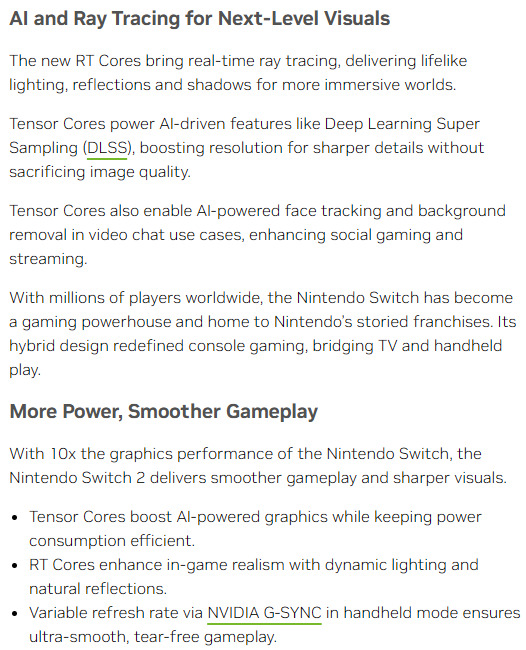
I do not know how much people like this or not (See recent RTX 40xx and 50xx launches to see how happy people are with Nvidia), but I think they are very much the ideal partners in crime with Nintendo this time around. As long as the Tensor hardware is power efficient enough as they claim, this will just be a boon for handheld gaming times, even if they're stuck at the same 2-6.5 hours as the launch model og switch. It also means it can be updated with time to improve games potentially, so if developers decide to take advantage of it and nvidia/nintendo makes it easy to just update the codebase of a game to get to a never version, we may actually have a case of games becoming more performant and/or better looking with time, assuming they are not running at native 4k already. That's neglecting the processing offloading for stuff like that goofy camera, microphone quality and other stuff

(seriously, if you got a recent enough Nvidia GPU try the Nvidia Broadcast app, it's does basically all the audio/video stuff nintendo showed recently, but now with a focused platform I think this is going to become excellent)
oh ya, it is odd that the stream from friend's framerate is like 12 fps, best guess there is because it uses the on board video encoder and decoded to handle it, and if each is a seperate channel, along with one for background recording/screenshots, plus whatever the games may need for their own dedicated use, I am not too surprised it got the cut on such a slim package. Suck though.
That leads into the dock.

I think the dock is fine. Does the job, has USB ports on the side to connect controllers and charge them (USB 2 tho, so I guess the camera attachement had to go to the top USB C port CORRECTION, I just saw MKBHD's recent switch 2 impression video, it can actually be attached elsewhere maybe. That's interesting, Photo attached below). I think it's as inoffensive as the Switch Oled dock, which does all it needed to do too plus ethernet. It's fine.

I guess while I'm here, let's touch upon the Microsd Express card slot.
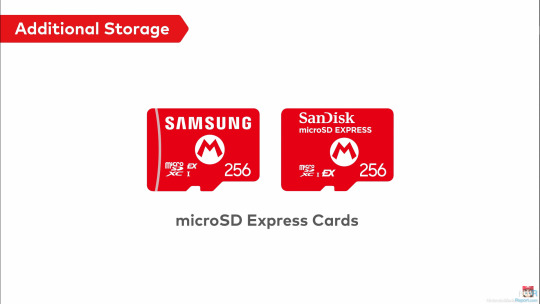
Let me preface this by saying, I knew that the standard was compatible with SD cards of prior so I found it odd they didn't make it clear if it could be used to at least get video/screenshots off, but they did!

Talking about the microSD express cards themselves, I may be in the minority here, but I am very very happy to see this get adopted. For those who are not in the know, it's basically much faster flash (that can be made for slightly more then an normal SD card) that runs off of the reader's PCIe Gen 4, allowing up to 2gb/s of read/write. Which is Crazy, and if they're mandating it to be required for games, that means the current 800mb/s read ones on the market right now is what the console will be using and games will finally load up so much faster. And, unlike the original SD cards, higher capacities like a terabyte already exist AND are not insanely more expensive over base sd cards.(I mean $20-25 for 256gb sd cards to $60 for same but microsd express is still a jump, but do you guys remember how fucking much 256gb sd cards costed originally? It was like $150, and I think 256gb storage will get further milage then the original 32gb storage the og switch had. And 1tb already cost $200 for when it comes out with the switch 2. Those prices will drop unless, uh... not within the scope of what I want to talk about)
Since we're on storage, 256gb of UFS storage? Like on phones, that can go multiple gigabytes per second read/write? Hell ya, we bout to get load times not much worse then other modern consoles.

Let's touch upon the joycons now.
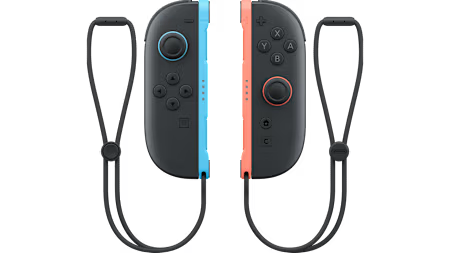
I like them, but as more in a sense of improvment over og switch joycons. Which, honestly, that's all they needed to do. The standout weird feature is the mouse on both, but I only see this as a plus. I want more of my PC games on portable systems, and as much as I want the steamdeck too, the switch form factor is still more portable. Just... please let the bigger joysticks be actually good and resistant to stick drift, I do not want to open them up just to replace the sticks with hall effect ones again. As a plus, I can't wait to see what insanity warioware is going to become now.
Oh ya, chat.
Surprised it took them 2 decades to finally do it, but they seem to have a lot of restraint there still, with extensive parent controls to help metigate any issues, so I'll only give them slightly less shit. Slightly. I'm going to call it though, there is going to be controversy about what eventually will occur over the gamechat. Can't wait!
Switch online services

I mean, it was inevitable. This, with the Wii games that's almost absolutely coming later, is going to be good. I suspect a pricebump is going to occur with the NSO that's going to make it cost almost a full game per year, but at least the retro selection is going to start going from crazy to insane, making it probably worth it. I just hope that the voucher program (shown below) gets expanded to more third parties, because as much as I like nintendo games for $50 a piece with this program, it needs to be way more expansive to make the $20 cost at this time to be online, let alone get the 2 vouchers for $100, worth it. If they do that, and keep on adding new actually fun (looking at you Zelda Notes... what the fuck are you) and nice to have to the service, I think it could become worth it in the near future.
I ALMOST FORGOT ONLINE DOWNLOAD PLAY, seriously that alone may be worth it because with both local and online, it means you do not have to force your friends to buy games they may otherwise never touch outside of playing with you. This is straight up a good, pro-consumer thing if others don't ignore it 24/7. I just hope the streaming quality will not be dogshit ahhaha....

(Shout out to nintendo actuallly using this a part to prevent scalpers, I don't like it much because I didn't pay for NSO on the og switch but at least this is a verifiable way to prevent scalpers. I just wish acconts from the Wii U/3ds era got special treatment :^) )

Since we're getting more into software, shout out to how sad the UI is still.
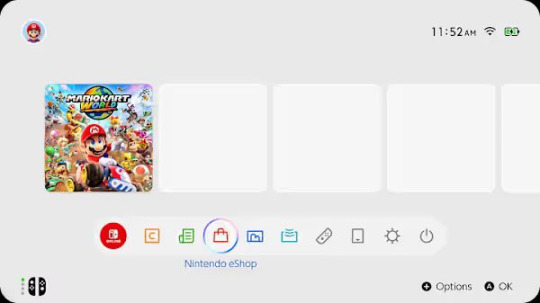
Nintendo, the literal bare minimun here is not just black and white customizable themes. You haven't done that for a generation. I would have much rather had the UI present from the DSi/Wii to Wii U/3ds era then this bland nothing soup. God. Now, onto the most devicive one, and the one that makes or breaks it for me. The games, and their prices.
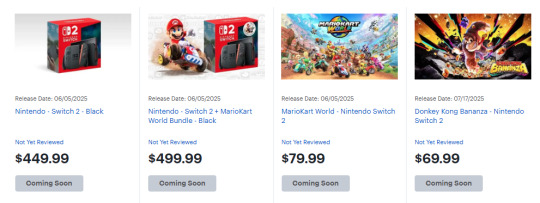
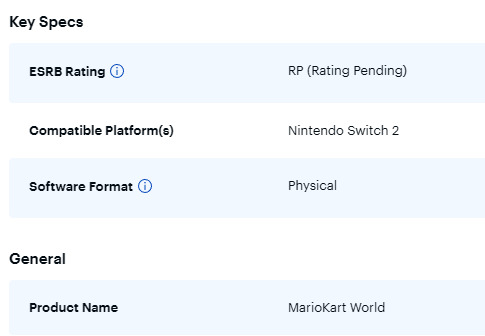
Let's get a few things clear, the $90 physical switch 2 game thing (which I had fallen for too) is in europe. If you're a suffering US citizen, the price is $80 for what seems to be big, high budget nintendo games, with everything else being $70, at least from the list of prices I've seen online.

About Game key cards, ya it's just the 'download play' games on the switch, but instead of a piece of paper that's one time, it's a re-usable cartridge that allows multiple downloads on other switches and acts like a physical one otherwise. This, in my opinion, is objectively better, and is not the default option. Other games will be on the Cartidge like og switch, see Cyberpunk 2077 on a 64gb one (seriously how the fuck they did that).
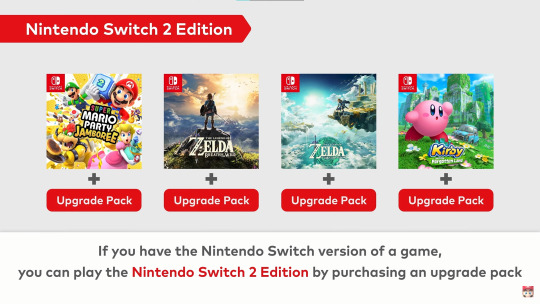
This switch 2 edition is on a case by case basis, so if it is just an fps/resolution bump, it is likely to be free. If it has a bit more, like some added extras and they know people would pay for the fps/resolution, see botw and totk will be $10, and if the content has basically DLC + all of the above, it's $20. Also, lol at welcome tour.
Seeing all of that, I'm iffy. I'm worried that the panic and reactions from everyone will lock the prices for everyone else at $80 since the publishers will take any chance to push prices up further, but if $70 stays I would reluctantly accept it. Unlike some people on the other platforms may say, in the past before $60 standardization, we had other options to play games like with rental stores, actually being around friends, and frequent discounts and bundles to get inventory moving. That does mean nowadays, especially with no sale nintendo, this price is here to stay, and if this is the cost to actually keep games good and not need astronomical sales to make back development costs, so be it. I am just not happy knowing that a lot of publishers will be using machine created/generated stuff each year for that price or $80 and expect no issues with it. The only thing I am very curious about is the capabilities of the switch 2 being somewhere between a PS4 and PS5, but able to handle PS5 ports, potentially making it the best way to play a lot of newer games on the go until valve decides in 2030 to make the steam deck 2.
Now everyone's favorite issues, price. I think it's reasonable, sucks a bit but reasonable. We're now dealing in a world where Nvidia has their focus on AI stuff, and knows that Nintendo wants backward compat + better stuff, so Nvidia likely is changing way more on parts. This world also includes inflation (seriously, $300 in 2017 is now closer to $400, and now there's all the extra nicer stuff slapped on top to justify a next gen). This world also includes ungodly uncertienty because of a a group in the wrong place in the wrong time. Considering all of this, honestly, $450 is fine. It sucks, I know it has pushed a few friends out from buying it w/o someone assisting them in the purchase, but it's fine. It's going to be a great refinement, which is all a sequel console had to be. The thing you have to know, nintendo is doing the thing again with previous controllers being compatible with the current system, so in reality (especially with me and my hall-effect modded controllers) the price to play with others will not be much more. I touched upon this already, but the game prices are iffy for me, and it's absolutely going to prevent me from buying as many games as I had for the og switch, but it's an dampener.
I will need more time to simmer (and see how my finacial situation is going to be), but I am currently leaning to I will try to get it. I'm on the fence, and I have a good chance of flipping to waiting later, or just not getting.
I may add more thoughts as I think them and remember I can use tumblr like this, but I think this is everything I wanted to get out that has been simmering in my head for a bit. Oh ya I almost forgot the most important thing, Homebrew. I love homebrew, it has given me extra life and enjoyment out of my og switch. If there is another launch edition vuln that allows homebrew, I want in.
16 notes
·
View notes
Text
Studying Language
Sorry I've been rather inactive, I'm slowly trying to get back into the swing of things!
This is something I’m actually qualified to talk about! I speak three languages fluently, albeit in need of a little practise, and I’m learning one more currently, with one on pause due to time constraints. Nevertheless, I feel pretty confident in my information lol. I’m also a qualified TEFL teacher and have worked abroad teaching English!
Full immersion is the best option. The best thing you can do is spend your time in a country that speaks your target language and force yourself to learn, once you have the “Hello,” “Goodbye,” “Where is the bathroom?” all mastered. In Ireland, there are places called Gaeltachtanna where you go for different lengths of time depending on the course and live in a town speaking exclusively Irish, usually staying with an Irish-speaking family, and going to classes for the language and for games and dances. Of course, that’s not an accesible option for everyone, so you could try going to places like your nearest Asian market, Eastern European market etc, and any areas in your city with a lot of immigrants that might speak your target language. If you have friends who speak that language, natively or just to a better level than you, ask to meet them for coffee and chat as much as you can in your language.
Immersion Part Two: Culture. The people who speak your target language natively do so not just becaus that’s the place in which they exist, but because that’s the place that they live- they get their groceries there, they go to school there, and their language developed because of the day-to-day, as well as unique aspects of their culture such as dances, music, and especially food. Learn about the culture of the country or countries that speak your target language. Eg, fold a paper crane or eat sushi if your language of choice is Japanese, watch an telenovela or go to a salsa class if your goal is to learn Spanish.
Watch TV shows in your Target Language. If you can’t access the locations, and even if you can, watching TV or movies is great because it’ll help you understand the cadences of natural speech that you can’t get from a textbook or formal class situation. Start with movies you might be familiar with like Disney movies (I will die on the hill of “Mother knows Best” from Tangled is better in Spanish). You can also combine your subtitles and audio, using subtitles in your own language at first, and challenge yourself to changing the subtitle.
Similar to the above points, use YouTube or Twitch to your advantage too. That’s probably a lot easier if your target language is English, but there are creators that speak in their non-English native language too. My friend watches a Mexican Minecraft YouTuber called Quackity who has a Minecraft server modded to feature a live translator between Spanish and English, which is very cool.
Read books in your Target Language. We don’t love The Chronicles of the Boy Wizard in this house, but the books are available in 85 languages. The Hobbit also has a tonne including Cornish, Thai, and Ukranian, and Twilight has about 37 translations, just to list a few well-known examples. Learn especially about books written originally in your target language.
Consume Media Originally from the Country or Countries that Speak that Language. Read the Witcher, watch Física o Química, join the dubbed vs subbed anime bloodbath. It can be so beneficial to your understanding of a language to see how those who speak it write it themselves, not just for localisation purposes. It can especially be useful for slang and dialects.
Duolingo and other apps. I’m swiftly approaching my 365 day duolingo streak,* and I fully intend to celebrate with pierogis and a green cake. But there are other options out there, and all of them are great for beginners. I can only speak about Duolingo as its the one I use, but I’m having a lot of fun with the layout of it. However, I do need real practice if I’m going to become actually fluent.
That’s it! I hope this has been helpful!
*I've surpassed it since writing this!! I'm at 400+!!
57 notes
·
View notes
Text
Outsourcing in 2025: Why India is Leading the Way in the Tech Revolution

In 2025, the global business landscape is evolving at lightning speed, and outsourcing remains a pivotal factor in helping companies stay competitive, innovative, and cost-effective. While outsourcing has long been a key business strategy, India has solidified its position as the global leader in this space, especially in technology. As organizations worldwide turn to outsourced tech solutions to fuel their growth, Indian companies, especially those like IT Idol Technologie, are leading the charge by reshaping the future of the tech landscape.
Outsourcing in 2025: The Need for Agility, Efficiency, and Innovation
As businesses face the pressure of rapidly evolving markets, the need for flexibility, innovation, and efficiency has never been more crucial. Outsourcing allows organizations to tap into global talent pools, access specialized expertise, and scale faster than ever before. In 2025, companies are increasingly turning to outsourced partners to help them adapt to new challenges, innovate with cutting-edge technologies, and deliver results quickly and cost-effectively.
Outsourcing offers a multitude of benefits: businesses can reduce overhead costs, enhance operational efficiency, and gain access to top-tier talent without the complexities of recruitment and training. In the tech industry, these advantages are particularly significant, as companies look for ways to stay ahead of the curve without draining resources.
India: The Epicenter of Outsourcing Excellence

Why has India become the go-to destination for outsourcing? The answer lies in its unique combination of highly skilled talent, cost-effective services, and a growing tech ecosystem. India has long been the leader in IT outsourcing, but in 2025, it has taken that legacy to new heights. Indian companies are not only providing basic IT services but are now at the forefront of delivering cutting-edge tech solutions, from custom software development to cloud services, data engineering, and more.
With a vast pool of highly educated professionals and a robust tech ecosystem, India offers the perfect environment for businesses looking to leverage outsourcing in the tech space. Indian tech companies have evolved to meet the growing demand for more complex and specialized services, and this is where firms like IT Idol Technologies are making a significant impact.
IT Idol Technologies: Leading the Paradigm Shift in Tech Outsourcing

IT Idol Technologies is at the heart of this transformation. As a forward-thinking outsourcing partner, IT Idol is helping businesses navigate the challenges of the digital age by offering tailored tech solutions that drive growth and innovation. Whether it’s custom software development, mobile app development, cloud computing, or digital commerce, IT Idol Technologies is leading the way in delivering high-quality, scalable, and cost-effective services that enable businesses to stay competitive.
The key to IT Idol’s success lies in its deep understanding of the tech landscape and its ability to adapt to the unique needs of each client. By leveraging its expertise in emerging technologies and staying ahead of industry trends, IT Idol ensures that businesses can continue to innovate while benefiting from the efficiency and cost savings that outsourcing provides.
How IT Idol Technologies is Helping Businesses Thrive in 2025
In 2025, companies are looking for outsourcing partners who can offer more than just basic services—they need a strategic ally who can provide innovative solutions that drive growth. IT Idol Technologies offers just that, with its specialized focus on high-demand areas like:
Custom Software Solutions: Helping businesses build tailored software to optimize operations and solve complex problems.
Mobile App Development: Developing native and cross-platform apps that engage users and enhance customer experiences.
Cloud Computing: Enabling businesses to scale quickly, securely, and cost-effectively with cloud-based solutions.
Digital Commerce: Providing comprehensive e-commerce solutions that help businesses reach customers and increase sales.
IT Idol’s ability to combine technical expertise with a customer-centric approach makes it a standout partner for businesses looking to stay ahead of the competition.
Unlock the Power of Outsourcing with IT Idol Technologies
As outsourcing continues to be a driving force in the global tech landscape, India remains the leader, offering businesses the ability to access top-tier talent and innovative solutions. IT Idol Technologies is at the forefront of this shift, providing companies with the tools and expertise they need to thrive in 2025 and beyond.
Ready to take your business to the next level? Whether you need custom software, mobile apps, cloud computing, or digital commerce solutions, IT Idol Technologies is here to help. Contact us today to discover how we can help you leverage the power of outsourcing to accelerate growth and innovation in your business.
#artificial intelligence#it outsourcing#it idol technologies#custom software development company#custom software solutions#custom software development#mobile app development#cloud computin#digital commerce#IT services#coding
2 notes
·
View notes
Text

Boost Shopify Revenue with A/B Testing
Boost your Shopify revenue with A/B testing experiments and data-driven insights to increase conversions and optimize your store.
Source: https://cro.media/insights/ab-tests/boost-shopify-revenue-ab-testing/
A/B testing is a powerful tool to increase your Shopify store's revenue by helping you make data-driven decisions. By running native A/B testing experiments on your Shopify store, you can optimize your customer experience and turn more visitors into paying customers. With easy-to-use features, you can start testing without any hassle.
Effortless Tracking with Instant A/B Testing
With Instant A/B Testing, there's no need for a JavaScript pixel to get started. The visual editor allows you to create and manage tests easily within minutes. This seamless setup ensures that you can test different variations of your Shopify store with zero technical headaches.
Smooth Experiment Operation
Run your A/B tests without worrying about disrupting your users' experience. The app is designed to serve experiments to the right audience and prevents redirects, making sure that your customers experience no interruptions while browsing your store.
Full Control Over Your Tests
Create separate URLs for each test to ensure a flawless and clean testing environment. By running your tests on individual pages, you can isolate variables and measure the success of each experiment with higher accuracy.
Easy Traffic Split
You have complete control over how much traffic goes to each version of your test. Define the percentage of traffic directed to each variant (A and B), allowing you to balance the experiment and gather precise insights.
Precision Insights Across the Funnel
Gain in-depth analytics with a full funnel view of your A/B tests. Track key metrics such as add-to-cart rates, checkout progression, and completed transactions to measure the true impact of your experiments on revenue.
Why Use Instant A/B Testing for Shopify?
Instant A/B Testing offers a 100% free solution to run experiments on your Shopify store, and no credit card is required to get started. This allows you to experiment with various store elements at zero cost while gathering valuable data that can drive better conversions.
Frequently Asked Questions
Do I need to subscribe to any service? No, Instant A/B Testing is completely free, with no subscription required.
How does it integrate with other apps? Instant A/B Testing works well with Instant Page Builder. You can easily create variants of your pages, publish them to your Shopify store, and test which version converts better.
Does A/B Testing affect my SEO? Since experiments run on separate URLs, there’s minimal risk to SEO performance. The app ensures that crawlers do not get redirected and uses Shopify Webpixel for tracking, keeping everything optimized for search engines.
Can I track custom redirects or use existing URLs? Yes, you can use both custom redirects and existing URLs for your A/B tests.
Do I need to enable app embeds? Yes, enabling app embeds is the only step needed to get started with A/B testing.
Start Your A/B Testing Today
Increase your Shopify store's revenue and conversion rates by running native A/B testing experiments. Take advantage of this free Shopify app to optimize your store with precision and ease. For businesses looking to optimize not just their A/B testing but their entire digital presence, consider exploring additional services like Shopify SEO Audit, Shopify CRO Audit, or Custom Shopify Development. These expert services can elevate your online store's performance even further.
If you're looking for more comprehensive solutions for Shopify, Shopify Services offers a range of professional services to boost your store's functionality and success.
2 notes
·
View notes
Text
Exploring the Azure Technology Stack: A Solution Architect’s Journey
Kavin
As a solution architect, my career revolves around solving complex problems and designing systems that are scalable, secure, and efficient. The rise of cloud computing has transformed the way we think about technology, and Microsoft Azure has been at the forefront of this evolution. With its diverse and powerful technology stack, Azure offers endless possibilities for businesses and developers alike. My journey with Azure began with Microsoft Azure training online, which not only deepened my understanding of cloud concepts but also helped me unlock the potential of Azure’s ecosystem.
In this blog, I will share my experience working with a specific Azure technology stack that has proven to be transformative in various projects. This stack primarily focuses on serverless computing, container orchestration, DevOps integration, and globally distributed data management. Let’s dive into how these components come together to create robust solutions for modern business challenges.

Understanding the Azure Ecosystem
Azure’s ecosystem is vast, encompassing services that cater to infrastructure, application development, analytics, machine learning, and more. For this blog, I will focus on a specific stack that includes:
Azure Functions for serverless computing.
Azure Kubernetes Service (AKS) for container orchestration.
Azure DevOps for streamlined development and deployment.
Azure Cosmos DB for globally distributed, scalable data storage.
Each of these services has unique strengths, and when used together, they form a powerful foundation for building modern, cloud-native applications.
1. Azure Functions: Embracing Serverless Architecture
Serverless computing has redefined how we build and deploy applications. With Azure Functions, developers can focus on writing code without worrying about managing infrastructure. Azure Functions supports multiple programming languages and offers seamless integration with other Azure services.
Real-World Application
In one of my projects, we needed to process real-time data from IoT devices deployed across multiple locations. Azure Functions was the perfect choice for this task. By integrating Azure Functions with Azure Event Hubs, we were able to create an event-driven architecture that processed millions of events daily. The serverless nature of Azure Functions allowed us to scale dynamically based on workload, ensuring cost-efficiency and high performance.
Key Benefits:
Auto-scaling: Automatically adjusts to handle workload variations.
Cost-effective: Pay only for the resources consumed during function execution.
Integration-ready: Easily connects with services like Logic Apps, Event Grid, and API Management.
2. Azure Kubernetes Service (AKS): The Power of Containers
Containers have become the backbone of modern application development, and Azure Kubernetes Service (AKS) simplifies container orchestration. AKS provides a managed Kubernetes environment, making it easier to deploy, manage, and scale containerized applications.
Real-World Application
In a project for a healthcare client, we built a microservices architecture using AKS. Each service—such as patient records, appointment scheduling, and billing—was containerized and deployed on AKS. This approach provided several advantages:
Isolation: Each service operated independently, improving fault tolerance.
Scalability: AKS scaled specific services based on demand, optimizing resource usage.
Observability: Using Azure Monitor, we gained deep insights into application performance and quickly resolved issues.
The integration of AKS with Azure DevOps further streamlined our CI/CD pipelines, enabling rapid deployment and updates without downtime.
Key Benefits:
Managed Kubernetes: Reduces operational overhead with automated updates and patching.
Multi-region support: Enables global application deployments.
Built-in security: Integrates with Azure Active Directory and offers role-based access control (RBAC).
3. Azure DevOps: Streamlining Development Workflows
Azure DevOps is an all-in-one platform for managing development workflows, from planning to deployment. It includes tools like Azure Repos, Azure Pipelines, and Azure Artifacts, which support collaboration and automation.
Real-World Application
For an e-commerce client, we used Azure DevOps to establish an efficient CI/CD pipeline. The project involved multiple teams working on front-end, back-end, and database components. Azure DevOps provided:
Version control: Using Azure Repos for centralized code management.
Automated pipelines: Azure Pipelines for building, testing, and deploying code.
Artifact management: Storing dependencies in Azure Artifacts for seamless integration.
The result? Deployment cycles that previously took weeks were reduced to just a few hours, enabling faster time-to-market and improved customer satisfaction.
Key Benefits:
End-to-end integration: Unifies tools for seamless development and deployment.
Scalability: Supports projects of all sizes, from startups to enterprises.
Collaboration: Facilitates team communication with built-in dashboards and tracking.

4. Azure Cosmos DB: Global Data at Scale
Azure Cosmos DB is a globally distributed, multi-model database service designed for mission-critical applications. It guarantees low latency, high availability, and scalability, making it ideal for applications requiring real-time data access across multiple regions.
Real-World Application
In a project for a financial services company, we used Azure Cosmos DB to manage transaction data across multiple continents. The database’s multi-region replication ensure data consistency and availability, even during regional outages. Additionally, Cosmos DB’s support for multiple APIs (SQL, MongoDB, Cassandra, etc.) allowed us to integrate seamlessly with existing systems.
Key Benefits:
Global distribution: Data is replicated across regions with minimal latency.
Flexibility: Supports various data models, including key-value, document, and graph.
SLAs: Offers industry-leading SLAs for availability, throughput, and latency.
Building a Cohesive Solution
Combining these Azure services creates a technology stack that is flexible, scalable, and efficient. Here’s how they work together in a hypothetical solution:
Data Ingestion: IoT devices send data to Azure Event Hubs.
Processing: Azure Functions processes the data in real-time.
Storage: Processed data is stored in Azure Cosmos DB for global access.
Application Logic: Containerized microservices run on AKS, providing APIs for accessing and manipulating data.
Deployment: Azure DevOps manages the CI/CD pipeline, ensuring seamless updates to the application.
This architecture demonstrates how Azure’s technology stack can address modern business challenges while maintaining high performance and reliability.
Final Thoughts
My journey with Azure has been both rewarding and transformative. The training I received at ACTE Institute provided me with a strong foundation to explore Azure’s capabilities and apply them effectively in real-world scenarios. For those new to cloud computing, I recommend starting with a solid training program that offers hands-on experience and practical insights.
As the demand for cloud professionals continues to grow, specializing in Azure’s technology stack can open doors to exciting opportunities. If you’re based in Hyderabad or prefer online learning, consider enrolling in Microsoft Azure training in Hyderabad to kickstart your journey.
Azure’s ecosystem is continuously evolving, offering new tools and features to address emerging challenges. By staying committed to learning and experimenting, we can harness the full potential of this powerful platform and drive innovation in every project we undertake.
#cybersecurity#database#marketingstrategy#digitalmarketing#adtech#artificialintelligence#machinelearning#ai
2 notes
·
View notes
Text
Cross-Platform App Development Services: Breaking Barriers and Expanding Reach

In today's digital era, mobile applications have become an integral part of our lives. Whether it's for social networking, e-commerce, or productivity, mobile apps have revolutionized the way we interact with technology. However, developing an app that can cater to the diverse needs of users across different platforms can be a daunting task for businesses. This is where cross-platform app development services come into play.
What is Cross-Platform App Development?
Cross-platform app development is the process of building mobile applications that can run on multiple operating systems, such as iOS and Android, using a single codebase. Unlike native app development, which requires separate codebases for each platform, cross-platform development allows businesses to save time, resources, and effort by creating a single app that works across various platforms.
The Advantages of Cross-Platform App Development:
1. Cost-Effectiveness: Developing separate apps for different platforms can be expensive. Cross-platform development enables businesses to significantly reduce costs by reusing a single codebase across multiple platforms. This approach also minimizes the need for hiring platform-specific developers, resulting in further cost savings.
2. Time Efficiency: Cross-platform frameworks and tools provide developers with the ability to write code once and deploy it on multiple platforms. This drastically reduces the time required for development, testing, and deployment, allowing businesses to bring their apps to market faster and gain a competitive edge.
3. Consistent User Experience: With cross-platform development, businesses can ensure a consistent user experience across different platforms. By using a single codebase, developers can maintain design and functionality consistency, resulting in a seamless experience for users, regardless of the device or operating system they use.
4. Wider Market Reach: By developing a cross-platform app, businesses can reach a broader audience as their application can run on various devices and operating systems. This expanded market reach enhances brand visibility and increases the potential user base, leading to greater customer acquisition and revenue generation.
5. Easy Maintenance: Updating and maintaining separate codebases for different platforms can be challenging. Cross-platform development simplifies the maintenance process as changes and updates can be applied to a single codebase, ensuring consistency and reducing the chances of introducing bugs or inconsistencies across platforms.
Choosing the Right Cross-Platform Development Framework:
When it comes to cross-platform app development, there are several frameworks available, each with its unique features and capabilities. The choice of framework depends on various factors such as project requirements, target audience, performance needs, and developer expertise. Some popular cross-platform frameworks include React Native, Flutter, Xamarin, and Ionic.
Partnering with Cross-Platform App Development Services:
While cross-platform app development offers numerous benefits, it requires technical expertise and experience to leverage the full potential of these frameworks. This is where partnering with cross-platform app development services can make a significant difference.
Professional app development services specializing in cross-platform development have the necessary skills, knowledge, and resources to create high-quality, feature-rich applications that can run seamlessly across multiple platforms. These services understand the intricacies of various frameworks, ensuring optimal performance and user experience.
Additionally, cross-platform app development services keep up with the latest industry trends and advancements, allowing businesses to incorporate cutting-edge features and technologies into their applications. They also provide ongoing support, maintenance, and updates, ensuring that the app remains up-to-date and compatible with the latest devices and operating system versions.
Conclusion:
Cross-platform app development services have emerged as a game-changer for businesses looking to develop mobile applications that can reach a wider audience while optimizing costs and development time. By leveraging the benefits of cross-platform development, businesses can break barriers, expand their reach, and deliver engaging experiences to users across multiple platforms.
Whether you are a startup or an established enterprise, partnering with cross-platform app development services can unlock new opportunities and drive your business forward in the ever-evolving mobile landscape.
Source
#AppDevelopment#WebDevelopment#MobileApps#WebApps#SoftwareDevelopment#UIUXDesign#MobileDevelopment#WebDesign#CodeLife#TechSolutions#AppDesign#MobileTech#WebDev#DigitalTransformation#ResponsiveDesign#Innovation#TechIndustry#AppSolutions#WebSolutions#CodeNerds
23 notes
·
View notes
Text
Amazon DCV 2024.0 Supports Ubuntu 24.04 LTS With Security

NICE DCV is a different entity now. Along with improvements and bug fixes, NICE DCV is now known as Amazon DCV with the 2024.0 release.
The DCV protocol that powers Amazon Web Services(AWS) managed services like Amazon AppStream 2.0 and Amazon WorkSpaces is now regularly referred to by its new moniker.
What’s new with version 2024.0?
A number of improvements and updates are included in Amazon DCV 2024.0 for better usability, security, and performance. The most recent Ubuntu 24.04 LTS is now supported by the 2024.0 release, which also offers extended long-term support to ease system maintenance and the most recent security patches. Wayland support is incorporated into the DCV client on Ubuntu 24.04, which improves application isolation and graphical rendering efficiency. Furthermore, DCV 2024.0 now activates the QUIC UDP protocol by default, providing clients with optimal streaming performance. Additionally, when a remote user connects, the update adds the option to wipe the Linux host screen, blocking local access and interaction with the distant session.
What is Amazon DCV?
Customers may securely provide remote desktops and application streaming from any cloud or data center to any device, over a variety of network conditions, with Amazon DCV, a high-performance remote display protocol. Customers can run graphic-intensive programs remotely on EC2 instances and stream their user interface to less complex client PCs, doing away with the requirement for pricey dedicated workstations, thanks to Amazon DCV and Amazon EC2. Customers use Amazon DCV for their remote visualization needs across a wide spectrum of HPC workloads. Moreover, well-known services like Amazon Appstream 2.0, AWS Nimble Studio, and AWS RoboMaker use the Amazon DCV streaming protocol.
Advantages
Elevated Efficiency
You don’t have to pick between responsiveness and visual quality when using Amazon DCV. With no loss of image accuracy, it can respond to your apps almost instantly thanks to the bandwidth-adaptive streaming protocol.
Reduced Costs
Customers may run graphics-intensive apps remotely and avoid spending a lot of money on dedicated workstations or moving big volumes of data from the cloud to client PCs thanks to a very responsive streaming experience. It also allows several sessions to share a single GPU on Linux servers, which further reduces server infrastructure expenses for clients.
Adaptable Implementations
Service providers have access to a reliable and adaptable protocol for streaming apps that supports both on-premises and cloud usage thanks to browser-based access and cross-OS interoperability.
Entire Security
To protect customer data privacy, it sends pixels rather than geometry. To further guarantee the security of client data, it uses TLS protocol to secure end-user inputs as well as pixels.
Features
In addition to native clients for Windows, Linux, and MacOS and an HTML5 client for web browser access, it supports remote environments running both Windows and Linux. Multiple displays, 4K resolution, USB devices, multi-channel audio, smart cards, stylus/touch capabilities, and file redirection are all supported by native clients.
The lifecycle of it session may be easily created and managed programmatically across a fleet of servers with the help of DCV Session Manager. Developers can create personalized Amazon DCV web browser client applications with the help of the Amazon DCV web client SDK.
How to Install DCV on Amazon EC2?
Implement:
Sign up for an AWS account and activate it.
Open the AWS Management Console and log in.
Either download and install the relevant Amazon DCV server on your EC2 instance, or choose the proper Amazon DCV AMI from the Amazon Web Services Marketplace, then create an AMI using your application stack.
After confirming that traffic on port 8443 is permitted by your security group’s inbound rules, deploy EC2 instances with the Amazon DCV server installed.
Link:
On your device, download and install the relevant Amazon DCV native client.
Use the web client or native Amazon DCV client to connect to your distant computer at https://:8443.
Stream:
Use AmazonDCV to stream your graphics apps across several devices.
Use cases
Visualization of 3D Graphics
HPC workloads are becoming more complicated and consuming enormous volumes of data in a variety of industrial verticals, including Oil & Gas, Life Sciences, and Design & Engineering. The streaming protocol offered by Amazon DCV makes it unnecessary to send output files to client devices and offers a seamless, bandwidth-efficient remote streaming experience for HPC 3D graphics.
Application Access via a Browser
The Web Client for Amazon DCV is compatible with all HTML5 browsers and offers a mobile device-portable streaming experience. By removing the need to manage native clients without sacrificing streaming speed, the Web Client significantly lessens the operational pressure on IT departments. With the Amazon DCV Web Client SDK, you can create your own DCV Web Client.
Personalized Remote Apps
The simplicity with which it offers streaming protocol integration might be advantageous for custom remote applications and managed services. With native clients that support up to 4 monitors at 4K resolution each, Amazon DCV uses end-to-end AES-256 encryption to safeguard both pixels and end-user inputs.
Amazon DCV Pricing
Amazon Entire Cloud:
Using Amazon DCV on AWS does not incur any additional fees. Clients only have to pay for the EC2 resources they really utilize.
On-site and third-party cloud computing
Please get in touch with DCV distributors or resellers in your area here for more information about licensing and pricing for Amazon DCV.
Read more on Govindhtech.com
#AmazonDCV#Ubuntu24.04LTS#Ubuntu#DCV#AmazonWebServices#AmazonAppStream#EC2instances#AmazonEC2#News#TechNews#TechnologyNews#Technologytrends#technology#govindhtech
2 notes
·
View notes
Text

Unlock the Potential of React Native
Ready to upgrade your Xamarin app? React Native is a powerful framework that delivers superior performance and a more engaging user experience. By transitioning to React Native, you can take advantage of the latest mobile development technologies and ensure your app stays competitive in the market. Our skilled developers specialize in making this transition smooth and hassle-free.
Reach out to us now and let's discuss how we can transform your app!
#ConnectInfosoft#ReactNative#XamarinUpgrade#MobileDevelopment#AppTransition#SuperiorPerformance#UserExperience#TechInnovation#MobileTech#AppDevelopment#ReactNativeDevelopers#TechUpgrade#ModernApps#MobileFramework#SeamlessTransition#CompetitiveEdge#FutureOfApps#TechTrends#AppEvolution#MobileSolutions#DevelopersCommunity#InnovationInTech#AppEnhancement#TechAdvancement#MobileInnovation#CodingLife#ReactNativeApp#SmoothTransition#HassleFreeDevelopment#AppSuccess
2 notes
·
View notes
Text
How I Learned Spanish
One of my superpowers is that I speak Spanish. No one expects it and I regularly surprise those who hear me for the first time. After asking me where I come from (shocker - not from a Spanish-speaking area or family), the second question people always ask is how did I learn? That is what I want to share today.
To start, allow me to share that I am a non-native Spanish speaker. I learned the language as an adult. I started learning at 20 or 21. In the beginning it was just to make jokes with coworkers and learn the curse words. Soon enough, it became an interest and a passion. I developed a love for the language.
Soon, I discovered that language is not just a combination of words. It is an expression of culture. Many words do not have direct translations, from English to Spanish, and vice versa. When you learn Spanish, you learn the words of course, but you also learn new meanings. You start to see your own native language differently. It is a journey not a destination.
So, how did I do it? Below, I will share what worked for me. I must note though that I did not necessarily learn in this order. Instead, these are all methods that I incorporated into my education. Start with what makes sense for you. Leave what doesn't resonate. There is no wrong way.
1. Music Videos with Lyrics
I give this suggestion to everybody. It is fun, and it is relatively easy.
Go to YouTube. Search for Spanish songs with lyrics ("con letra"). If you don't like the first song, keep searching. Search for genres that you like. Don't listen to something because you have to. Rather, listen to it because you enjoy it and want to learn it. That will make the learning easier.
While listening, pause the video as needed and translate what you need.
There are many benefits to learning the music. You learn how people actually speak. You learn the cadence of language. You learn slang. You learn vocabulary that isn't in your study books. Instead of learning rote rules (which are important but they have their time and place), you learn actual natural language. Also, I have discovered that learning music helps you remember the words. Catchy songs are great.
2. Listen to people or songs or shows, even if you don't understand.
Learning Spanish was never easy for me but it was convenient. I worked in restaurants and half of the staff and customers spoke the language. So, I had access to the language. What helped me is that I listened intently to what they were saying. I didn't do this to be nosey but to aide my understanding. I started to notice common sounds and words. Once I got those down, I could understand the basic gist of conversations. Eventually, I could understand full sentences (sometimes).
After all, learning in a class setting or language app doesn't necessarily translate to understanding. It usually leads you to passing a quiz that you forget a week later. Active listening exposes you to how the language is officially spoken, not just textbook pronunciations. (By the way, people don't usually speak according to the textbooks!)
3. Speak the language
This seems easy. Of course, you are going to speak the language when you are learning it. Right? It's actually harder than it seems. In the beginning, I was so nervous about speaking that I was afraid to do it. I did it anyway. I probably sounded horrible. In fact, I know I did. People laughed when I spoke. And not because I was telling jokes. I said the wrong things. I misunderstood conversations. However, I persisted.
The more you speak, the better you get. Sure, you are sloppy in the beginning, but you improve. Besides, you have to start somewhere. Face your fears. Sound silly. It doesn't matter. It will help your advancement.
4. Purchase some grammar books
So far, I have highlighted some advantages of learning the natural way people speak, of learning what the textbooks won't teach you. However, grammar rules are important. In the beginning, people forgive you for your mistakes, but you do need to learn the official rules of language.
I am not suggesting expensive textbooks. You can go on Amazon and get a couple of books for $20-$30 each. Learning Spanish, I think I purchased 4 books in all. One for Verbs and Tenses. One for Adjectives. "Breaking out of Beginner Spanish" (I highly recommend). " One for Spanish Idioms. They were all great but the Spanish Idioms one was a bit difficult. Each region uses different idioms and it is difficult to know which ones are universal. Try them out but a native Spanish speaker from Mexico may not understand an idiom from Spain. The other three books are fundamental, though.
5. Don't give up.
Some days I felt great. Some days I felt horrible. The more I learned, the more I realized I didn't know. Some days it felt that as soon as I grasped one concept, I completely forgot another. In fact, 14 years later, I still have more to learn. Speaking Spanish is hard, yet completely worth it. It exposes you to different worlds and cultures. When you feel like giving up, take a brief step back and take a break. But never give up. Keep going. The more you practice, the better you will become. The more you practice, the easier it will be. You can do it.
2 notes
·
View notes
Text
SOURCE PROTOCOL
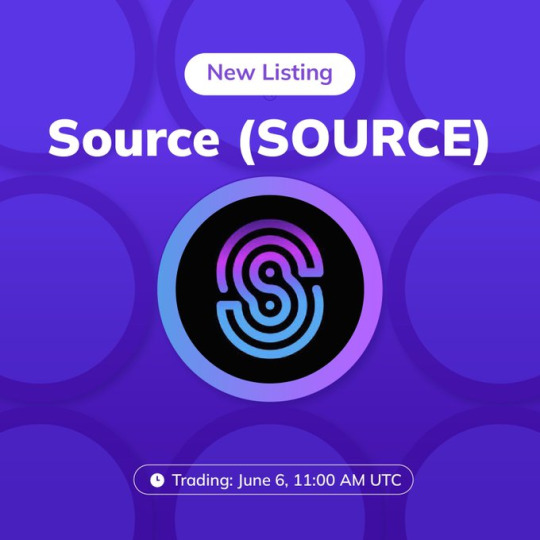
SOURCE is building limitless enterprise applications on a secure and sustainable global network. Defi white-labelled services, NFT markets, RWA tokenization, play-to-earn gaming, Internet of Things, data management and more. SOURCE is providing blockchain solutions to the real world and leveraging the power of interoperability.
SOURCE competitive advantages over other blockchain projects
For builders & developers — Source Chain’s extremely high speeds (2500–10000+ tx / per second), low cost / gas fees ($0.01 average per tx), and scalability (developers can deploy apps in multiple coding languages using CosmWasm smart contract framework), set it apart as a blockchain built to handle mass adopted applications and tools. Not to mention, it’s interoperable with the entire Cosmos ecosystem.
For users — Source Protocol’s DeFi suite is Solvent and Sustainable (Automated liquidity mechanisms create a continuously self-funded, solvent and liquid network), Reduces Complexity (we’re making Web 3.0 easy to use with tools like Source Token which automate DeFi market rewards), and we’ve implemented Enhanced Security and Governance systems (like Guardian Nodes), which help us track malicious attacks and proposals to create a safer user environment.
For Enterprises — Source Protocol is one of the first to introduce DeFi-as-a-Service (DaaS) in order for existing online banking and fintech solutions to adopt blockchain technology with ease, and source also provides Enterprise Programs which are complete with a partner network of OTC brokerages, crypto exchanges, and neobanks that create a seamless corporate DeFi experience (fiat onboarding, offboarding, and mutli-sig managed wallets)

Why Source Protocol
Firstly, many protocols are reliant on centralized exchanges for liquidity, limiting their ability to scale independently. This creates a lot of the same issues traditional finance has been plagued with for decades.
Next — slow tx speeds, high costs, limited scalability, and inability to collaborate with other chains, has created severe limitations in Gen 2 blockchain infrastructure.
Lastly, there still exists a level of complexity in blockchain applications that remains a barrier to entry for the average user, and there is not enough focus on building “bridges” for the enterprise to adopt this technology easily and quickly.
In summary, consumers are eager for a blockchain ecosystem that can securely and sustainably support mass adopted applications. That’s why we’ve built Source!
Source Protocol’s ecosystem
Source Protocol’s ecosystem includes a full DeFi Suite, a members rewards program and white-label integration capabilities with existing online Web 2.0 enterprises:
Source Swap — An Interchain DEX & AMM built on Source Chain for permission-less listing of $SOURCE-based tokens, native Cosmos SDK assets, cw-20’s, and wrapped Binance Smart Chain (BEP-20) assets.
Source One Market — A peer to peer, non-custodial DeFi marketplace for borrowing, lending, staking, and more. Built on Binance Smart Chain with bridging to Source Chain & native Cosmos SDK assets.
Source Token $SRCX (BEP-20) — the first automated liquidity acquisition and DeFi market participation token built on Binance Smart Chain.
Source One Token $SRC1 (BEP-20) — a governance and incentivized earnings token that powers Source One Market.
Source USX $USX (BEP-20) — Source One Market stablecoin backed and over collateralized by a hierarchy of blue chip crypto assets and stablecoins.
Source Launch Pad — Empowering projects to seamlessly distribute tokens and raise liquidity. ERC-20 and BEP-20 capable.
Source One Card & Members Rewards Program — users can earn from a robust suite of perks and rewards. In the future, Source One Card will enable users to swipe with their crypto assets online and at retail locations in real time.
DeFi-as-a-Service (DaaS) — Seamless white-label integration of Source One Market, Source Swap, Source Launch Pad, and/or Source One Card with existing online banking and financial applications, allowing businesses to bring their customers DeFi capabilities.
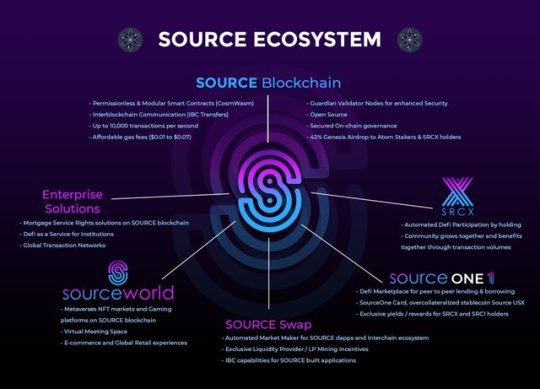
Source Protocol Key Components
Sustainable Growth model built for enterprise involvement and mass application adoption
Guardian Validator Nodes for enhanced network security
Integration with Source Protocol’s Binance Smart Chain Ecosystem and Decentralized Money Market, Source One Market
Source-Drop (Fair community airdrop and asset distribution for ATOM stakers and SRCX holders)
Interoperable smart contracts (IBC)
High speed transaction finality
Affordable gas fees (average of $0.01 per transaction)
Highly scalable infrastructure
Open-source
Permission-less Modular Wasm + (EVM)
Secured on-chain governance
Ease of use for developers
conclusion
SOURCE is a comprehensive blockchain technology suite for individuals, enterprises and developers to easily use, integrate and build web3.0 applications. It is a broad-spectrum technology ecosystem that transforms centralized web tools and financial instruments into decentralized ones. Powering the future of web3,
Next — slow tx speeds, high costs, limited scalability, and inability to collaborate with other chains, has created severe limitations in Gen 2 blockchain infrastructure.
Lastly, there still exists a level of complexity in blockchain applications that remains a barrier to entry for the average user, and there is not enough focus on building “bridges” for the enterprise to adopt this technology easily and quickly.
In summary, consumers are eager for a blockchain ecosystem that can securely and sustainably support mass adopted applications. That’s why we’ve built Source!
For More Information about Source Protocol
Website: https://www.sourceprotocol.io
Documents: https://docs.sourceprotocol.io
Twitter: https://www.twitter.com/sourceprotocol_
Instagram: https://www.instagram.com/sourceprotocol
Telegram: https://t.me/sourceprotocol
Discord: https://discord.gg/zj8xxUCeZQ
Author
Forum Username: Java22
Forum Profile Link: https://bitcointalk.org/index.php?action=profile;u=3443255
SOURCE Wallet Address: source1svnzfy5fafuskeaxmf2sgvgcn6k3sggmssl8d7
2 notes
·
View notes
Text
Empowering Businesses with Ionic App Development Services
In the dynamic landscape of mobile app improvement, corporations are constantly in search of revolutionary solutions to interact with their target market efficaciously. With the proliferation of smartphones and tablets, having a sturdy mobile presence has come to be imperative for staying competitive in the present-day market. This is wherein Ionic app development businesses step in, imparting flexible and green solutions to build cross-platform cellular packages that captivate customers and power business increase.
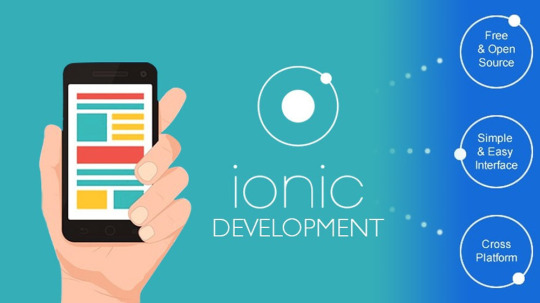
Unveiling the Power of Ionic App Development
Ionic is an open-source framework that lets builders build fantastic, function-wealthy cellular packages using internet technology which includes HTML, CSS, and JavaScript. Leveraging web technology permits Ionic app development companies to create go-platform programs that run seamlessly on diverse devices and working structures, consisting of iOS, Android, and the web.
1. Cross-Platform Compatibility:
One of the key advantages of Ionic app development is its potential to create cross-platform programs with a single codebase. This drastically reduces development time and costs, as developers can write as soon as possible and deploy throughout multiple systems, making sure of consistency in personal enjoyment throughout gadgets.
2. Native-Like Performance:
Despite being constructed with net technologies, Ionic packages offer native-like overall performance and responsiveness. Through technology like Capacitor or Cordova, Ionic apps can get the right of entry to device capabilities and APIs, turning in a continuing consumer experience with smooth animations, rapid loading instances, and fluid navigation.
3. Rapid Development Cycle:
Ionic's development environment is characterized by its simplicity and simplicity of use, facilitating a fast improvement cycle. With features like Ionic CLI (Command Line Interface) and Ionic DevApp, developers can streamline the development technique, iterate speedy, and take a look at their applications in actual time throughout multiple devices.
4. Extensive UI Component Library:
Ionic comes with a rich set of pre-designed UI additives and layouts, allowing builders to create visually attractive and intuitive personal interface results easily. From buttons and paperwork to navigation bars and modals, Ionic's UI thing library empowers builders to construct polished and expert-looking applications with minimal attempts.
5. Community Support and Ecosystem:
The Ionic framework boasts a colorful community of builders, designers, and lovers who actively contribute to its surroundings. From open-supply plugins and extensions to comprehensive documentation and tutorials, the Ionic network affords helpful resources and support, fostering collaboration and innovation in app development.
Industries Leveraging Ionic App Development Services
1. E-Commerce:
Ionic app improvement agencies cater to the growing desires of e-trade organizations through building characteristic-wealthy buying apps, inventory control structures, and customer engagement structures. These applications allow e-commerce manufacturers to supply seamless shopping reports, customized tips, and stable payment gateways to their clients.
2. Healthcare:
In the healthcare enterprise, Ionic apps are utilized to create telemedicine systems, patient portals, appointment scheduling structures, and health tracking programs. These apps enhance accessibility to healthcare services, facilitate remote consultations, and empower sufferers to manipulate their health correctly from their cell devices.
3. Education:
Educational establishments and e-gaining knowledge of structures leverage Ionic app improvement offerings to create interactive knowledge of apps, online course platforms, and educational video games. These applications guide far-off mastering, personalized education, and knowledge dissemination, catering to the numerous needs of college students and educators globally.
4. Finance:
Ionic apps are revolutionizing the finance zone by imparting answers together with cell banking apps, virtual wallets, and funding systems. With sturdy security features and seamless personal reports, Ionic-powered finance apps allow people to manage their budgets comfortably and securely on the go.
5. Travel and Hospitality:
Ionic app improvement businesses play an important position in growing travel reserving systems, inn reservation systems, and tour courses for the travel and hospitality industry. These programs provide intuitive interfaces, actual-time updates, and seamless booking reviews, enhancing the overall journey experience for users internationally.
Conclusion
Ionic app improvement organizations are at the leading edge of innovation within the cellular app improvement landscape, empowering organizations across diverse industries to construct compelling and function-rich packages that resonate with their target audience. With its cross-platform compatibility, native-like performance, and giant surroundings, Ionic offers a versatile and efficient framework for growing mobile applications that drive engagement, enhance the personal experience, and propel enterprise boom in the state-of-the-art virtual era.
2 notes
·
View notes
Text
Exploring the Difference Between Web Development and App Development
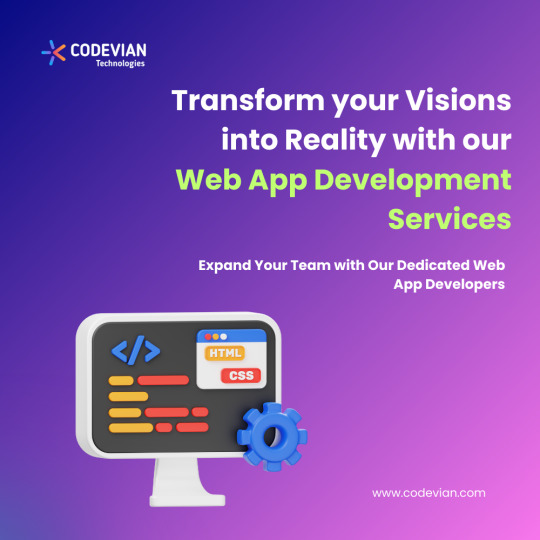
Hey there, tech enthusiasts! So, you've heard about web development and app development, but you're not quite sure what sets them apart? Don't worry, I'll break it down for you in simple terms!
First things first, what exactly is web development? Well, think of it like building a house on the internet! Web development involves creating websites or web applications that can be accessed through a web browser, like Google Chrome or Safari. It's all about designing, building, and maintaining websites that people can visit and interact with online.
Now, let's talk about app development. This is like building a cozy little home on your smartphone or tablet! App development involves creating mobile applications that are installed directly onto your device, like games, social media apps, or productivity tools. It's all about designing, building, and maintaining applications that people can download and use on their mobile devices.
So, what's the difference between web development and app development? Here are a few key distinctions:
Platform: The biggest difference between web development and app development is the platform they're built for. Web app development services focuses on creating websites or web applications that are accessed through a web browser on desktop computers or mobile devices. App development, on the other hand, focuses on creating mobile applications that are installed directly onto a device and accessed through an icon on the home screen.
Technology: Web development typically involves technologies like HTML, CSS, and JavaScript for creating the front end (what users see and interact with) and languages like PHP, Python, or Node.js for creating the back end (the server-side logic). App development, on the other hand, often involves languages like Java or Kotlin for Android development, Swift or Objective-C for iOS development, or frameworks like React Native or Flutter for cross-platform development.
Distribution: Web applications are usually accessible to anyone with an internet connection and can be accessed through a web browser without the need for installation. Mobile applications, on the other hand, need to be downloaded and installed onto a device from an app store like the Apple App Store or Google Play Store.
User Experience: The user experience of web applications and mobile applications can be quite different. Web applications are designed to work across different devices and screen sizes, so they often have a responsive design that adapts to fit the user's device. Mobile applications, on the other hand, are specifically designed for use on mobile devices and can take advantage of features like touch screens, GPS, and push notifications.
In conclusion, while web development and app development share some similarities, such as creating digital experiences for users, they also have key differences in terms of platform, technology, distribution, and user experience. Whether you're interested in building websites or mobile applications, both fields offer exciting opportunities to unleash your creativity and make an impact in the digital world!
2 notes
·
View notes
Text
Korean Language Learning Through Online Platforms: Establishing a New Educational Paradigm
Korean Language Learning Through Online Platforms: Establishing a New Educational Paradigm
The language learning landscape has changed significantly in recent years, with online platforms emerging as a dominant force in education. This change has been especially noticeable in the area of Korean language learning, where the accessibility and diversity of online resources has laid the foundation for a new educational paradigm. The rise of digital learning environments has provided unprecedented access to Korean language education to learners around the world, breaking down geographic and financial barriers that once impeded access to such resources.
One of the main advantages of online Korean learning platforms is that they can provide a personalized learning experience. Unlike traditional classroom environments where the pace and content are typically uniform, online platforms provide learners with the flexibility to tailor their learning to their individual needs and learning styles. This personalized approach not only improves the learning experience, but also increases the efficiency with which learners become proficient in Korean. A good reference site for this is www.canko.app, Google search: canko - learn Korean, and moreover, the interactive nature of many online platforms engages learners in ways that traditional textbooks cannot. Using multimedia content such as videos, audio clips, and interactive exercises, learners can immerse themselves in the language in a more dynamic and engaging way. This not only helps retain knowledge, but also helps learners develop a more nuanced understanding of the language and cultural context.
Another important advantage of learning Korean online is the opportunity for real-time interaction and feedback. Many platforms facilitate communication with native speakers and fellow learners, providing valuable practice for speaking and listening skills. This interactive component is critical to language acquisition because it allows learners to apply what they have learned in realistic conversational situations.
Online communities and forums further enhance the learning experience by providing support and motivation. Learners can share tips, resources, and experiences to create a sense of community that encourages continued engagement and development. This collaborative environment mimics the social aspects of traditional classroom learning while providing the added benefits of accessibility and global accessibility.
The rise of online Korean learning platforms reflects a broader trend in digital education, with learners looking for flexible, accessible, and effective alternatives to traditional education models. As these platforms continue to evolve by incorporating advanced technologies such as artificial intelligence and machine learning, the potential for personalized, interactive, and immersive learning experiences will only expand.
In conclusion, the emergence of online platforms as the primary medium for learning Korean signals a shift toward a more accessible, personalized, and interactive teaching paradigm. These developments demonstrate the potential of digital technologies to not only democratize language learning and make it accessible to a wider audience, but also to transform the way we learn and engage with new languages and cultures. As this trend continues, the future of language education will become increasingly digital, offering a promising outlook for learners around the world.
Referring page URL : https://www.canko.app Android: https://play.google.com/store/apps/details?id=com.bbsoft.study.canko iphone: https://apps.apple.com/app/canko-learn-korean-language/id6449929850
1 note
·
View note
Text
Predicting and programming: enemies for life (part 2)
Day 42 - Dec 17th, 12.023
This is the direct continuation of yesterday's post. I hope that I'm able to continue my daily journals as usual, but there's a strong possibility that one day or another I will not able to post, or need to post after midnight. Also, the entries probably will be shorter or just small updates sometimes even on weekends, but I will try to write them on the morning to be able to have time and brain to do something bigger and with better quality. And some posts I could even need to split into two if I need to stop writing one in the middle, like what's happened yesterday. There's no need to go into details, I don't want to expose my personal life nor of the people around me, I just want to inform that this end of year is not being great to my partner, so I want to be with her as much as I can to help and support her to whatever she needs to.
"A ghostly server"
Like I said in the last part, the application was complaining about not having a server, and the stranger, it was complaining about not having the development server running. This as a production build of the application, the embedded web-app were a static one, a static HTML file, why was it complaining about the server!? I tried searching around the Tauri's GitHub issues, but there was nothing about it, and creating an issue wasn't in my mind at the time because again, I am short in time and couldn't wait for a fix.
So because Tauri wasn't working, and I didn't even want to think about how to fix this problem, I switched back to CapacitorJS. This process was somewhat easy, because both of them are a "wrapper", so I just needed to move the web app part of the application from a template to another, but it was somewhat time-consuming (I'm not so accustomed to Vim and my new file explorer, so navigating was somewhat slower, and like every JavaScript project, just setting it up a template can be time-consuming). But after setting it up, Capacitor compiled, and the app was working as normal without any differences.
Framework hopping
While that was happening, when I started the project, I also wasted a lot of time choosing what framework to use. "Why?" One, JavaScript is an ecosystem that in general can be somewhat overwhelming with choices; Two, I already used SvelteKit for my last application and projects, so this time I wanted something different; Three, I wanted to try something more "native-like".
Web as Native
I started trying to use Framework7, because it has a collection of components and routing that emulates the native-app experience, and most important to me, it had the updated Material Design 3 (Material You) design; with Svelte, my primary UI framework of choice. But it didn't work that well. The routing wasn't how I liked it to be, and Framework7 is a somewhat old framework as it seems (it uses Gulp as its build system and the last commits were a month ago, the project is not that active), it stills a great project, but somewhat difficult to integrate with newer thing like Svelte 4 and Vite. After not being able to, I tried to KonstaUI with Svelte, but ended up with the same results. If you know something about this area of trying to make web apps feel like a native app, you are probably thinking something like "why you didn't use Ionic?", and the main reason is that it stills uses Material Design 2, and personally I like more how the newer version looks. Also, Ionic doesn't have official support for Svelte, and even knowing that the community package is good, I already used it in the past and wanted something new to try.
So, after probably hours, if not a day, trying that, I hopped into another idea. I found something called Beer CSS, a library that creates a Material You look and app using just CSS pretty much, so I could use any framework that I liked! Nonetheless, because it was pure JS and CSS, I thought it would be good to use Astro, so I could also take advantage of its new View Transitions feature, and could use Svelte still for the interactivity blocks. But as you can already tell if you know Astro, it's probably not the best idea to use a static site generator (SSG) as a mobile application framework, however it was working, and I was being able to create something and actually develop the application part of things and not just continue setting up new projects.
Lack of documentation
But then some cracks started to open. Beer CSS's documentation is not the greatest for me, it's mostly code examples and there's pretty much no words about customization and how the CSS words and/or how to manipulate it, and it seems that you really need to follow Material's system and hierarchy to it to work properly. I don't have time for this, and I already wasted 2 to 3 days fighting my way around all of this.
Also, while this was happening, the problem with Tauri also happened, which for some reason also made me switch from Astro to SvelteKit. Why? I don't know really, for me the problem with the server could be related to it, but of course it didn't work, and I had to switch to Capacitor like I said.
Blank screen and broken dreams
And then, another problem appeared out of nowhere, the built app with CapacitorJS started to have a total black screen when I opened it. There were no errors in the console, warnings on the screen, nothing, the app simply stopped working, and I couldn't find anything about it on the issues, and being honest, at this point I had already wasted around a week and couldn't handle it anymore. The idea of not being able to give at least something in time was storming my mind and I ended up wasting another day procrastinating, because I couldn't handle and think of solutions.
I had so many ideas for this app and now everything stopped working, I was exhausted, this was supposed to be something special for my girlfriend, and I don't want to lose the date again, even more now when she's passing difficult times in her life. I need to do and try something.
Compromises
This is where I am right now. I have less than a week to finish this project, and the app itself is way unfinished than I anticipated it would be days ago. So, what we do when this happens? Compromises, I already had in mind that I would create just some features until the date and then update over time, but now it will be just one feature and as an online website for now.
One of the features of this app is an interactive messaging page, to give complements and things like that, but for now I will try to repurpose it to some predefined messages and just express out of my heart to her using it. Do I want to be simple as that? No, but it only what I can do for now, and hopefully I will be able to add more things as time passes, I really want to do something special and specific for my girlfriend. Thankfully, porting it to a native app in the future won't be so hard, and I already have some ideas now on how to fix the past bugs that impossibilitaded me from porting it, however I will try to focus more on the features themselves for now.
Knowing my girlfriend, she will understand, but again, it's more of me to her thing in my mind.
---
Today's artists & creative things
Song: Hello, World - by Louie Zong I don't know why, writing this post just remembered me this music.
---
Copyright (c) 2023-present Gustavo "Guz" L. de Mello <[email protected]>
This work is licensed under the Creative Commons Attribution-ShareAlike 4.0 International (CC BY-SA 4.0) License
2 notes
·
View notes